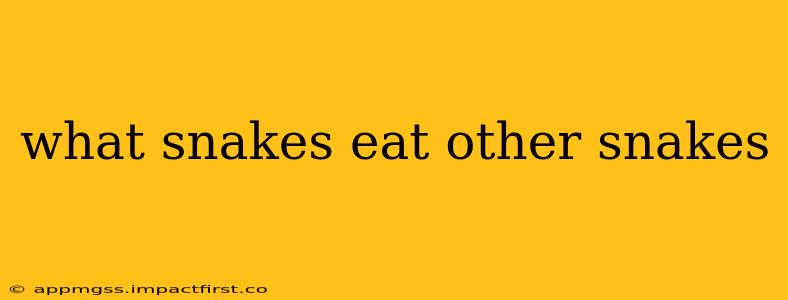Many snake species engage in ophiophagy, the practice of eating other snakes. This isn't just a rare occurrence; it's a significant part of the diet for several snake families around the world, showcasing the complex dynamics within snake ecosystems. Understanding which snakes prey on others helps us appreciate the intricate balance of nature and the fascinating survival strategies employed by these reptiles.
This article will explore the world of snake-eating snakes, answering common questions and delving into the specifics of this captivating behavior.
What types of snakes eat other snakes?
Several snake families boast members known for their ophiophagous habits. Some of the most prominent include:
-
Colubrids: This is the largest family of snakes, and a surprising number of colubrids include snakes in their diet. Species like the rat snake, king snake (including the milk snake), and some hognose snakes are well-known for their consumption of other snakes.
-
Elapids: While many elapids are venomous, and their venom is often lethal to humans, some species also prey on other snakes. Certain species of coral snakes and even some cobras have been observed engaging in ophiophagy.
-
Viperids: While not as commonly known for it as some other families, some viper species will eat other snakes when the opportunity presents itself. This is often opportunistic feeding, rather than a primary dietary staple.
-
Pythonidae: Many pythons, especially the larger species, are capable of and often do consume other snakes. Their size and constriction ability allow them to subdue and swallow even larger prey items, including other snakes.
What size snakes do other snakes eat?
The size of the prey snake is highly dependent on the size and species of the predator snake. A larger snake, such as a king snake or a python, can consume snakes significantly smaller than themselves. Smaller ophiophagous snakes will naturally target smaller prey. It's not uncommon for a snake to eat a snake of roughly half its own size or even smaller. However, some remarkably large snakes have been recorded consuming prey nearly their own size.
How do snakes kill and eat other snakes?
The method of killing and consuming another snake varies depending on the predator snake's species and capabilities. Some common methods include:
-
Constriction: Larger constrictors, like pythons and boas (while not exclusively ophiophagous), overpower their prey by coiling around them and tightening their grip until the prey suffocates.
-
Venom: Venomous snakes, like some elapids and viperids, inject venom to paralyze or kill their prey before consuming it.
-
Overpowering: Some non-venomous snakes, like king snakes, may simply overpower their prey using strength and agility, subduing it before swallowing it whole.
Are all snakes cannibals?
No, not all snakes are cannibals. While many species are opportunistic feeders and will consume other snakes when available, it's not a universal trait across all snakes. Cannibalism in snakes is often observed in situations where food resources are scarce, or during intraspecies competition. Most snakes primarily prey on other animals, such as rodents, amphibians, birds, or lizards.
Do snakes eat poisonous snakes?
Yes, some snakes are known to consume venomous snakes. King snakes, for example, are immune to the venom of many poisonous snakes in their range, allowing them to prey on venomous species without harm. This immunity is an evolutionary adaptation that has provided these snakes with a significant advantage. However, they are not immune to all venoms, and consuming a larger or more venomous snake could still pose a risk.
Why do snakes eat other snakes?
The primary reason snakes eat other snakes is for sustenance. Snakes are carnivores, and other snakes represent a readily available food source, especially in environments where other prey might be scarce. Ophiophagy contributes to the regulation of snake populations and maintains the balance within the ecosystem.
Understanding the complex world of ophiophagy offers a fascinating glimpse into the intricate relationships and survival strategies of these incredible reptiles. By exploring the specific behaviors and adaptations of various snake species, we gain a deeper appreciation for the dynamic and interconnected nature of the natural world.
